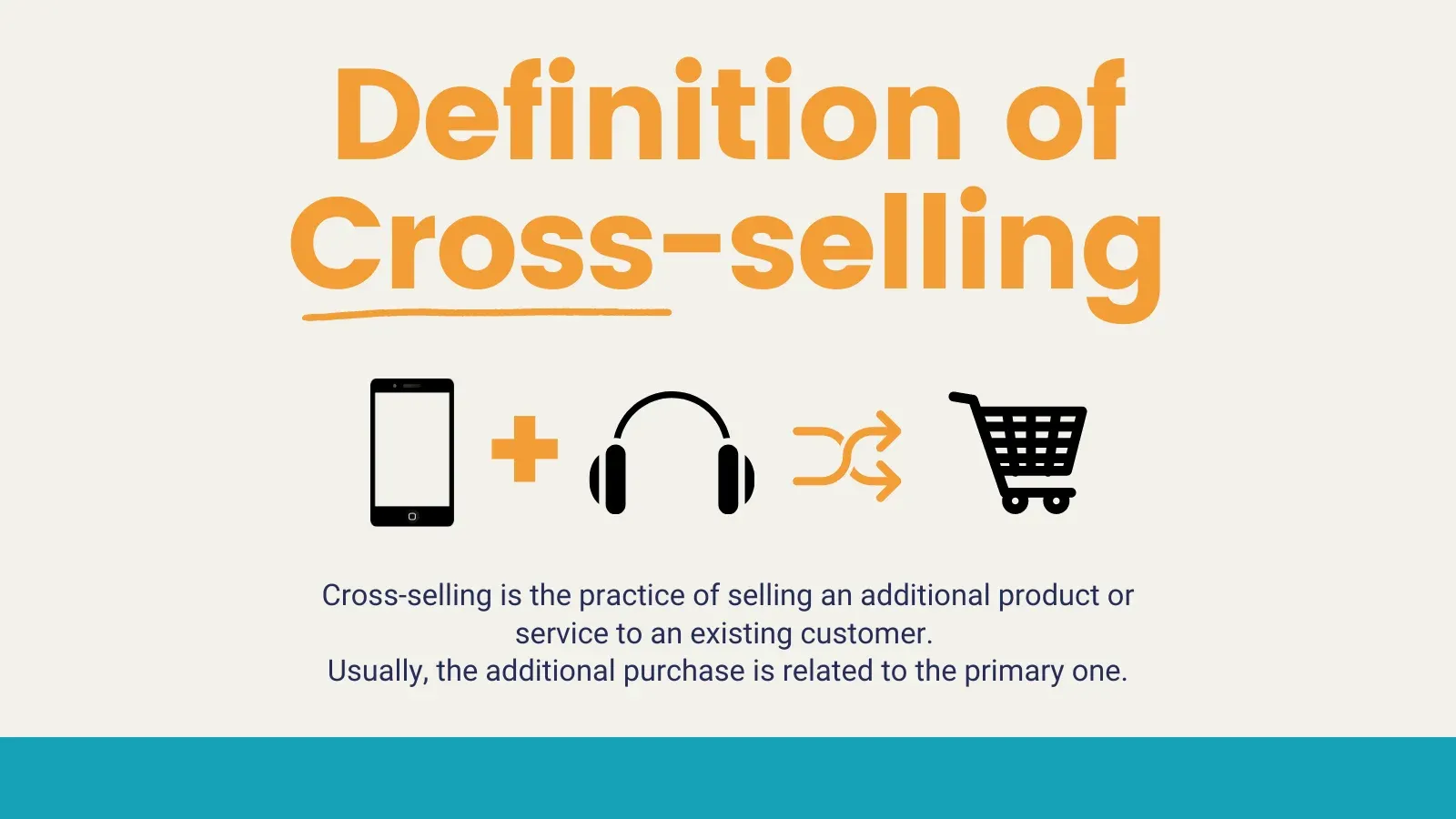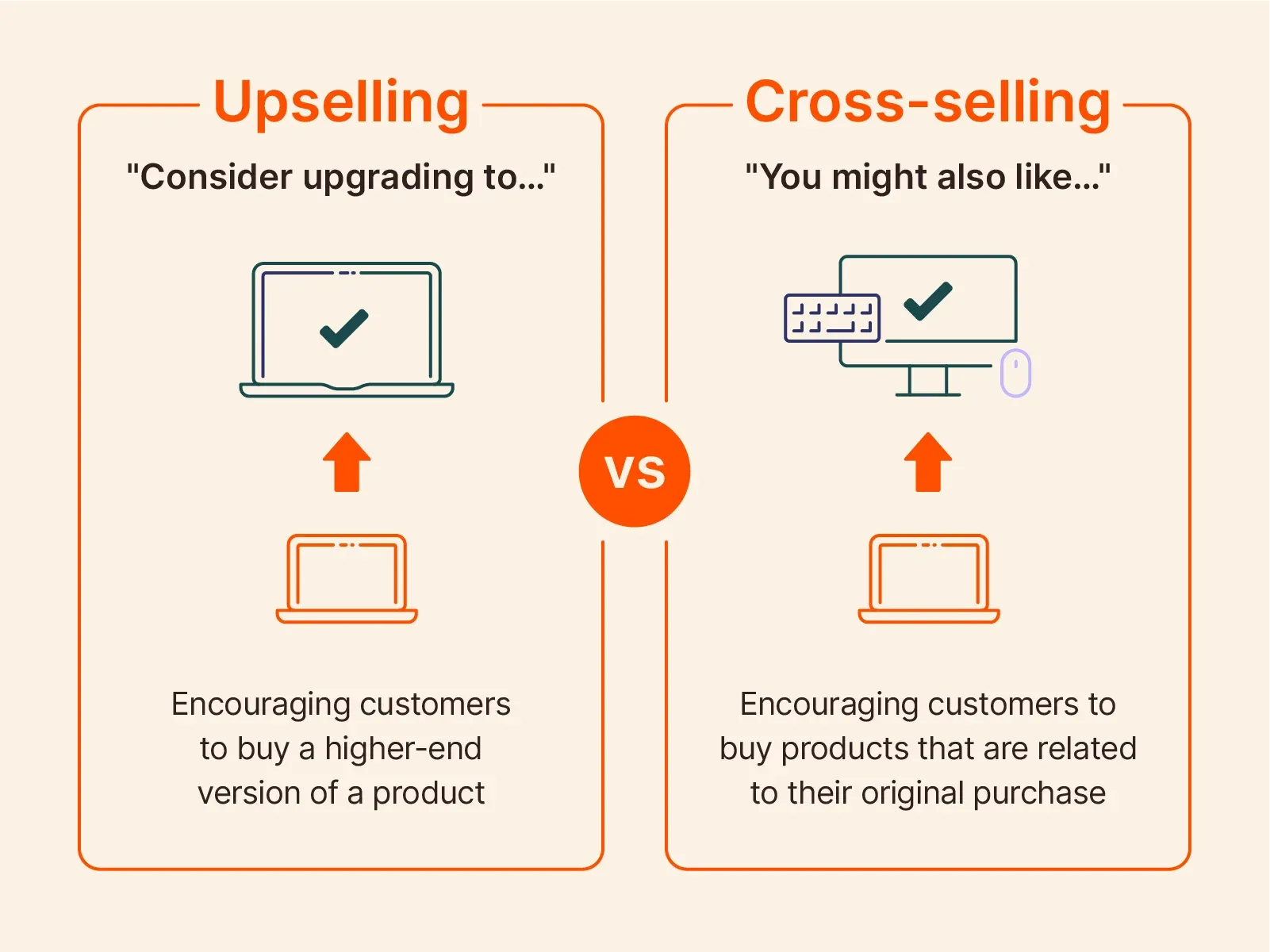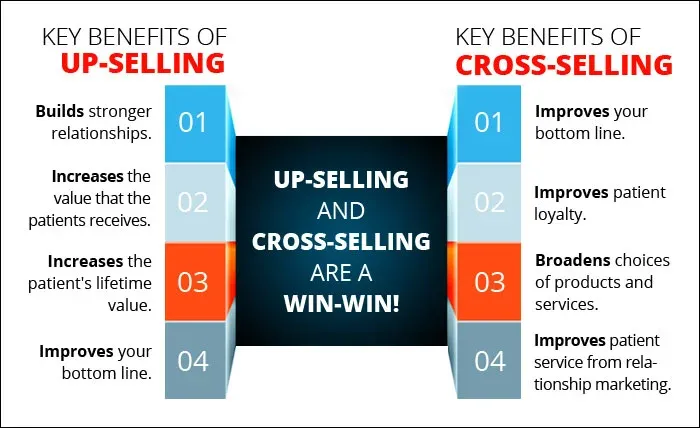Cross-selling and upselling are two essential strategies in the world of e-commerce marketing that can help increase revenue and improve customer loyalty.
Cross-selling involves recommending complementary products to customers, while upselling involves presenting them with more premium options.
Both techniques encourage customers to make additional purchases and increase their overall order value.
In this blog post, we will explore effective cross-selling and upselling strategies businesses can implement to boost their sales and customer engagement.
We will discuss the benefits of these techniques, share real-world examples, and help businesses optimize their approach.
Let us start with cross-selling.
Cross-Selling: What is it?

Cross-selling is a marketing technique employed by e-commerce businesses to recommend additional products or services that complement the original purchase made by a customer.
It involves suggesting related or complementary items that can enhance the customer's experience or meet their additional needs.
Cross-selling aims to increase the average order value and encourage customer loyalty.
Benefits of Implementing Cross-Selling Strategies in E-commerce
Implementing cross-selling strategies in an e-commerce business can yield several benefits.
Firstly, it can help increase revenue by encouraging customers to make additional purchases.
By presenting relevant and valuable products, businesses can tap into the existing customer base and drive more sales.
Cross-selling also enhances the customer experience by providing them with options that meet their specific needs or preferences.
Additionally, it can improve customer satisfaction and loyalty, as customers perceive value in receiving personalized recommendations.
Examples of Successful Cross-Selling Campaigns in the E-commerce Industry
Amazon's "Frequently Bought Together" feature: This feature suggests other products that are frequently purchased together with the item the customer is currently viewing. For example, when a customer adds a camera to their cart, Amazon recommends additional items such as memory cards, camera bags, and tripods to enhance their photography experience.
Spotify's personalized playlists: Spotify utilizes cross-selling techniques by creating personalized playlists for its users based on their listening habits and preferences. These curated playlists often feature songs from artists the user already enjoys, encouraging them to explore new music while increasing their engagement with the platform.
Now let us see the effective upselling strategies.
Understanding Upselling

Upselling is a sales technique used in e-commerce marketing that involves persuading customers to purchase a higher-priced product than their original choice.
It focuses on presenting the customer with upgraded or premium options that offer additional features, benefits, or value.
The aim is to increase the customer's average transaction value and maximize revenue per order.
Benefits of Implementing Upselling Strategies in E-commerce

Implementing upselling strategies in e-commerce can bring various advantages to businesses.
Firstly, it can significantly increase profits by encouraging customers to choose higher-priced products, resulting in a higher revenue per sale.
Upselling also allows businesses to showcase their premium or advanced offerings, highlighting unique features and benefits that may not be present in lower-priced alternatives.
Moreover, by providing personalized recommendations for higher-value products, businesses can enhance the overall customer experience and satisfaction.
Examples of Successful Upselling Campaigns in the E-commerce Industry
Apple's iPhone upgrade program: Apple's upgrade program entices customers to upgrade to the latest model of the iPhone by offering trade-in options and monthly payment plans. By highlighting the advanced features and improved performance of the newer models, Apple effectively upsells customers to higher-priced devices.
Airbnb's "Plus" accommodation option: Airbnb upsells customers by offering a premium "Plus" accommodation category, which includes homes that have been verified for quality and comfort. By providing a selection of higher-priced, top-tier listings, Airbnb attracts customers looking for an enhanced travel experience and willing to pay more for it.
Now we will see the effective upselling and cross-selling strategies.
Suggested Reading:
Optimizing Your Online Store: E-commerce Marketing Best Practices
Effective Upselling and Cross-selling Strategies
Upselling and cross-selling are important ways for businesses to increase revenue and provide more value to customers.
With the right strategies, you can boost sales without overwhelming customers.
Know Your Products
To upsell or cross-sell effectively, you need to understand your own products and services inside and out. Which products are complements? Which upgrades would benefit customers the most? Take time to map out your entire product catalog and identify natural bundles and upgrades.
Ask Questions
When interacting with customers, ask open-ended questions to learn more about their needs. What problem are they trying to solve? What is their budget? How will they use the product? Gathering this context helps you recommend the right additional products and services.
Make Recommendations
Once you understand a customer's situation, you can make targeted product recommendations. For example, if someone is buying a basic phone plan, you could recommend adding unlimited data or international calling. Or someone getting a basic software could upgrade to a premium version with extra features.
Explain Benefits Clearly
When upselling or cross-selling, be clear about the specific benefits customers will gain.
Don't just say "This upgrade has more features." Explain which features directly address their needs and why they will find value.
For example, "Unlimited data means you can stream music anytime without worrying about overages."
Offer Discounts
People are likelier to say yes to add-ons if they seem like a good deal. You can sweeten potential upgrades by using temporary discounts, bundling promotions, or loyalty rewards. Just be sure discounts don't undermine your regular pricing.
Provide Multiple Options
Rather than pushing a single upgrade, give customers meaningful choices. They may not want the top-of-the-line option but something in between. Present a range of products at various price points to appeal to different budgets.
Suggested Reading:
Ask for the Sale
After clearly explaining benefits, discounts, and options, go ahead and ask if the customer would like to add the upgrade or extra product to their order. Don't be afraid of hearing no - the worst they can say is no. But if you never ask, the answer will always be no.
Follow Up After Purchase
Your work isn't done after the initial sale. Send follow-up emails or messages highlighting how to use or get the most out of their new products. Include additional upgrade and bundle offers. Staying in contact keeps your offerings top of mind for future purchases.
Cross-Train Employees
All customer-facing staff should understand your full catalog of products and services to enable cross-selling and upselling. Train employees on recommended scripts and how to identify opportunities. Empower everyone to provide the best customer experience and increase average order value.
Upselling and Cross-Selling via Email Marketing
Email marketing presents opportunities for upselling and cross-selling existing customers. When sending promotional emails, include links or banners for higher-tier products and services.
For example, if a customer purchased the basic subscription, promote the features of the premium subscription and provide an easy call-to-action to upgrade. Email is also a channel to cross-sell complementary products - someone who bought a laptop can be offered accessories like a laptop bag and an external hard drive.
Personalization helps increase conversion rates - segment customers and tailor recommendations based on their purchase history and preferences. Timely and relevant upsell and cross-sell offers provide value rather than coming across as spammy.
Upselling and Cross-Selling via Chatbots
Chatbots allow brands to interact conversationally with customers and look for upsell and cross-sell opportunities in real-time. Chatbots can suggest superior options and bundles when customers inquire about a product or service.
The chatbot can promote faster shipping methods if someone asks about shipping charges. Chatbots can be programmed with cross-selling logic as well - someone browsing smartphones can be offered protective phone cases.
Chatbots can track the shopping cart and recommend additional purchases based on what's already in the cart. The conversational nature of chatbots makes upselling and cross-selling more natural and contextual. And chatbots are available 24/7 to engage every customer.
And taking your first step towards automation isn't that tough. Meet BotPenguin- the home of chatbot solutions. With all the heavy work of chatbot development already done for you, deploy chatbots for multiple platforms and make multi-channel support look easy for business:

Track Results and Improve
Analyze metrics like attachment rates, average order value, and revenue per customer over time. See which strategies are most effective for which products or customer types.
Refine your approach continually based on data to maximize results from upselling and cross-selling.
With practice and the right strategies, upselling and cross-selling can become a natural part of every customer interaction.
Focus on truly understanding customers and adding value through complementary offers. With the right execution, it feels like a benefit to them, not a sales pitch.
Conclusion
Cross-selling and upselling strategies play a vital role in the success of e-commerce marketing efforts.
By effectively implementing these strategies, businesses can increase their revenue, enhance customer satisfaction, and drive profitability.
The seamless customer experience and personalized recommendations are key to persuading customers to accept cross-sell and upsell offers.
Measuring and assessing the effectiveness of these strategies helps businesses optimize their approach and improve results over time.
By continually refining their cross-selling and upselling techniques, e-commerce businesses can achieve long-term success and establish stronger relationships with their customers.
Suggested Reading:
Frequently Asked Questions (FAQs)
What is the difference between cross-selling and upselling in e-commerce?
Cross-selling involves recommending related or complementary products, while upselling encourages customers to purchase a higher-end version of the same product, both strategies aimed at increasing the overall purchase value.
How can I effectively implement cross-selling on my e-commerce platform?
Implement personalized product recommendations, utilize customer purchase history data, and optimize product bundling to suggest relevant items, thereby enhancing the customer's shopping experience and boosting sales.
What are some successful upselling techniques to increase order value in e-commerce?
Employ persuasive product comparisons, offer limited-time upgrades, and provide exclusive discounts for premium versions, encouraging customers to opt for higher-value products and driving incremental revenue for the business.
How can I identify the right products for cross-selling on my e-commerce website?
Analyze customer preferences, conduct market research, and utilize data analytics to identify related or complementary products that align with the primary purchase, ensuring targeted cross-selling opportunities for maximum impact.



